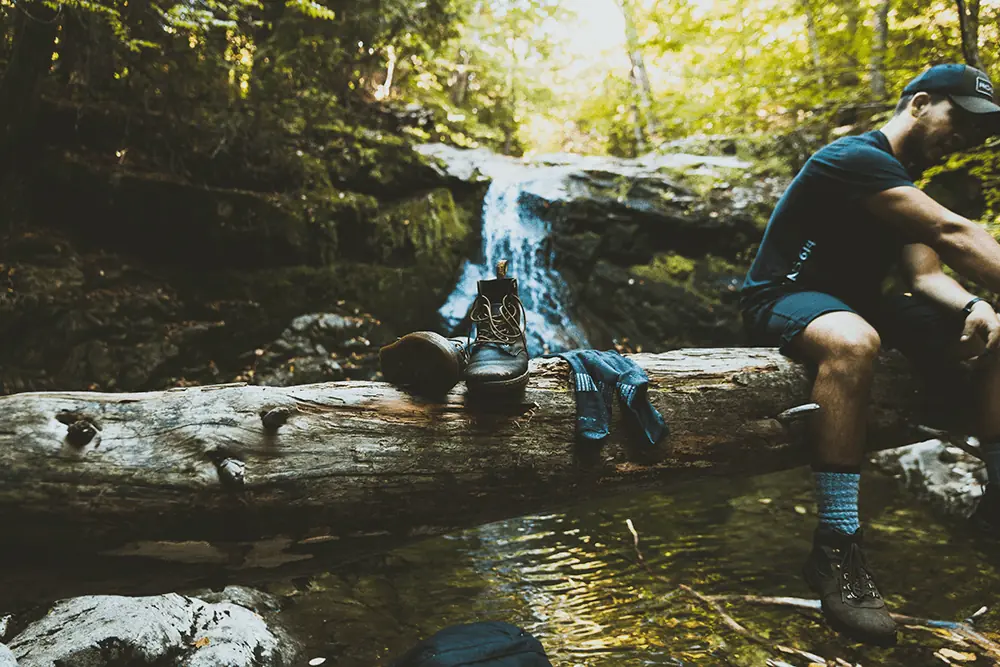What Kind of Socks to Wear Hiking in the Summer?

One of the things you’ll start to notice as you get older is how fast the year goes by, for me at least.
Summer will be here before you know it, which means more folks will be outdoors.
One of my favorite things to do, usually on a whim, is to lace up my hiking boots and hit the trails.
Hiking in the summer is a great way to de-stress and enjoy the outdoors.
And some of you might be wondering what kind of socks to wear in the summer.
There are many different types of socks that you can wear on hikes, but it comes down to three main things:
- Breathability
- Moisture-wicking
- Comfortability
In my opinion, it’s one of the most overlooked but valuable articles of clothing for recreational hikers.
When hiking, look for socks made of a wool blend with a lightweight, breathable design yet plush in areas that are prone to cause hotspots or blisters.
Wait, wool?
The material that’s used for winter clothing to keep you warm?
I know it might sound contradicting.
But wool helps regulate your body temp depending on the external temperature.
So on cold days, it will retain your body temperature.
It does the same on hot days by drawing moisture from your skin and regulating temperature. The only difference is you’ll want to opt for thinner wool socks in the summer instead of wintertime.
With that said, you still might have a few questions, such as:
- Is there an optimal type for comfort and performance?
- What are the benefits and drawbacks of different kinds regarding length, thickness, material, and care tips?
All these questions will be answered as we explore what kind of socks to wear hiking in the summer.
We’ll look at how choosing the right sock can make all difference between having a successful or miserable hike.
Let’s dive in.

Types of Socks
Here are some of the most common types of socks:
Cotton
Cotton socks can be a great selection for summertime trekking because most of you have cotton socks. They’re also lightweight and affordable, making them an ideal option for those on a budget.
However, cotton is not very durable and quickly loses shape when wet or stretched out. Cotton is not known for its sweat-wicking properties compared to fabrics like wool or synthetics.
You can get away with cotton socks for short, easy trails. I would stay away from them for more technical hikes, especially if there’s a chance of getting them wet.
Cotton doesn’t dry as fast as wool; you don’t want to hike in soaking-wet socks. It sucks.
Merino Wool
Merino wool socks are my preferred option for hiking in the summertime.
It’s naturally temperature regulating, so it helps keep your feet cool in hot weather while providing warmth when temperatures drop at night. It’s also extremely soft and comfortable against the skin, plus it provides excellent moisture-wicking capabilities that help keep your feet dry even during long hikes. Merino wool can be pricier than other sock fabrics, such as cotton or synthetics.
And the best part?
If they get wet, they dry pretty fast in the sun or near a fan.
Synthetic
Synthetic materials, such as polyester and nylon, are often utilized to craft performance socks for summertime hiking; they possess durability and moisture-wicking properties that make them suitable.
Synthetic fabrics offer good support without feeling too bulky or heavy on your feet. Plus, they tend to last longer than natural fibers like cotton or wool before needing replacement due to wear and tear from use over time.
The main downside with synthetic fabric is that it doesn’t breathe quite as well as natural fibers, which can cause your feet to become sweaty after extended periods of activity outdoors in warm weather conditions.

Benefits
For summer hikes, the right sock can make all the difference in comfort and support.
Comfort and Stability
Select a sock that offers cushion and arch support for optimal outdoor comfort and stability while still breathable.
A good quality sock should provide cushioning and arch support while being lightweight enough for proper air circulation. This helps keep feet cool and comfortable during long hikes in hot weather.
Temperature Regulation
Temperature regulation is another key factor when selecting socks for summer hikes.
The best option would be one made from breathable fabrics like merino wool or synthetic materials that help wick away moisture and regulate body temperature by keeping feet cool even on hot days.
Merino wool is especially great because it’s naturally anti-microbial, which helps prevent odor buildup after hours of sweating on the trail. Synthetic fibers also offer superior comfort as they tend to have more elasticity than cotton socks, making them better at hugging your foot shape without feeling too tight or restrictive around the ankle area.
Sock Length
For summer hiking, sock length can range from ankle to knee-high.
For hikers, the selection of sock length for summer treks provides varied levels of comfort and protection depending on individual requirements.
Ankle Length Socks are a great option for those who prefer minimal coverage or want to avoid bulkier socks that can be uncomfortable in hot weather.
These socks provide light cushioning around the foot and ankle without being too bulky or restrictive. They’re perfect for shorter hikes when you don’t need extra support from thicker material but still want protection from blisters and other abrasions caused by rubbing against your shoes.
Mid-Calf Length Socks offer more coverage than ankle-length socks while still providing breathability in warm temperatures.
They come up higher on the calf, providing additional cushioning and increased arch support. This can help reduce fatigue during long hikes or treks over rough terrain where extra shock absorption is needed.
Mid-calf socks protect your lower legs from brush and debris that could otherwise irritate you as you walk through thick vegetation areas.
Sock Thickness
Three types of sock thicknesses are available:
- Lightweight or thin socks
- Medium-weight or moderate-thickness socks
- Heavyweight or thickest possible options for maximum cushioning and protection
Lightweight
Lightweight or thin socks are designed to be breathable and lightweight. They provide minimal insulation but can still keep your feet dry from sweat. These are best suited for short hikes on hot days when you don’t need a lot of cushioning or support. Thin socks also work well with shoes that fit snugly, as they won’t add any bulkiness that could cause discomfort while walking long distances.
Medium / Moderate
Medium-weight or moderate-thickness socks offer more cushioning than their thinner counterparts without sacrificing too much breathability.
These are great if you plan on taking longer hikes where extra padding is needed to protect your feet from rocks and other obstacles along the trail. The added insulation will also help regulate temperature, so your feet don’t get too cold outdoors camping under the stars during cooler evenings.
If you anticipate taking on more challenging trails, investing in these thicker options may be the ticket to avoiding blisters when daybreak arrives – an investment that will certainly pay off.
No matter what type of sock thickness you choose, make sure it fits properly; otherwise, all that extra padding may not do its job correctly.
An ill-fitting sock is like putting a bandaid over an open wound – pointless.
Take time to try on different pairs until you find one that feels comfortable before heading off into nature’s playground with confidence knowing your feet will stay safe no matter how far they roam.
Care Tips
Maintaining your hiking socks during the summer requires particular attention; some essential measures should be taken to guarantee they remain in perfect condition.
Washing instructions should be followed carefully, as improper washing can lead to shrinkage or fading of colors.
Hand-washing is generally recommended for most hiking socks since machine washing can cause them to lose their shape and elasticity over time. I like to hand wash my wool socks in soap made of wool fabric and let them air dry.
Drying instructions are also important when caring for your hiking socks during hot weather conditions.
It’s best not to wring out excess moisture from your socks before hanging them up – shake off any extra water, then lay flat on a towel until completely dried (ideally away from direct sunlight).
If necessary, you can speed up drying time by turning the sock inside out so that both sides get exposed equally while drying; however, be sure not to put them too close together as this will prevent air circulation and result in dampness remaining inside the material.
FAQs
Do you need hiking socks in the summer?
The type of socks you should wear for hiking depends on the climate and terrain.
Generally speaking, if it is warm enough that you don’t need a jacket or other heavy layers, then lightweight socks are usually sufficient for comfort.
However, thicker woolen socks can provide extra cushioning and insulation in cooler climates or when trekking through rocky terrain where your feet may take more of a beating than usual. Ultimately, it’s wise to ponder the environment of your hike before opting for the most suitable sock.
What are the best socks for hot summers?
When selecting socks for hot weather, several factors must be considered. First, choose socks made from lightweight materials such as cotton or merino wool for optimal comfort and breathability.
Also, choose a sock with cushioning in the heel and toe areas so you can walk comfortably without blisters.
Lastly, opt for lightweight designs that won’t weigh down your feet during long days of hiking or fishing in warm weather conditions. Heed these tips, and you’ll be sure to secure the ideal socks for your summer activities.
What wool socks are best for hot weather?
For hot weather, wool socks are a great choice for their insulation and breathability, as well as being lightweight yet effective in keeping feet fresh.
They provide excellent insulation and breathability while still being lightweight and comfortable. Wool is also naturally odor-resistant, which helps keep your feet smelling fresh during long days outdoors.
Look for merino wool or alpaca blends, as these materials offer superior softness and durability compared to traditional wool.
Additionally, make sure the sock has an appropriate fit with arch support for optimal comfort and performance. Finally, consider choosing a pair of moisture-wicking socks to help pull sweat away from your skin when temperatures rise.
How do you choose summer socks?
When choosing summer socks, there are several factors to consider.
First, to begin with, pick a material that is lightweight and ventilated to keep your feet fresh in the heat.
Secondly, choose a sock with good moisture-wicking capabilities to prevent sweat from building up on your feet.
Thirdly, look for a sock for maximum comfort by cushioning in areas such as the heel and toe area or extra arch support if needed.
Finally, pick a pair of socks that will last you through multiple wears and washes without losing their shape or color too quickly. Considering all these factors when selecting summer socks, you can ensure optimal comfort throughout your outdoor activities this season.
Before You Go
If you want to have the best experience as a new hiker, I highly suggest you check out my other hiking resources:
- Hiking For Beginners Guide (And Finding Epic Trails)
- What Is The Difference Between A Walking Trail And A Hiking Trail?
- How Should a Hiking Backpack Fit? (Proper Fitting And Sizing Guide)
- 7 Reasons You Should Wear Wool Socks For Hiking
- The Complete Guide to Buying Hiking Backpacks: Everything to Know






